If the steel industry were a country, it would be ranked third in the world in terms of carbon dioxide emissions, after China and the United States. Steel production accounts for between 7 and 9 percent of the world’s total annual carbon emissions, according to the World Steel Association. “That’s massive coming from one sector,” says Sandeep Nijhwan, CEO and co-founder of Boulder, Colorado–based Electra. “It’s also one of the hardest-to-green sectors.”
But Electra is taking on the challenge. The company says that its new electrochemical process could fully decarbonize steelmaking. And the zero-emission steel could cost the same as conventional steel.
Steelmaking’s giant carbon footprint comes from converting iron oxide ore into iron, which comprises about 97 percent of steel. The ore is melted at 1,600 °C in huge blast furnaces fired by coal, the same way it has been done for decades. Burning coal not only provides energy, Nijhawan explains, it is also a reducing agent. That is, the carbon in it acts with the iron oxide, forming bonds with the oxygen. The result is pure iron plus carbon dioxide. The process is responsible for 90 percent of the carbon emissions that come from making steel. “When we talk about steel decarbonization, we’re really talking about decarbonizing iron making,” Nijhawan says.
Electra has come up with an “electrochemical hydrometallurgical process” that directly reduces iron oxide into iron at temperatures of 60°C, colder than a cup of coffee; no blast furnace or coal burning is required.
The process involves first dissolving iron oxide ore in an aqueous acid solution to precipitate out metals. Hydrometallurgy is commonly used to produce copper and zinc, Nijhawan says. “The difference is that iron oxide doesn’t like to go into solution. Once it gets into solution, it’s unstable and wants to come out of the solution very rapidly.”

He and his team have come up with a way around that issue. Using a proprietary process, they separate and remove the impurities in the iron ore. Finally, they extract the iron out of the solution by passing an electric current through it.
Some companies are trying to use hydrogen or biomass fuel instead of coal to heat and convert iron ore in blast furnaces. But those alternative fuels remain expensive. Besides, that would not eliminate the need for expensive, high-grade iron ores, says Nijhawan. “Cost is a big driver for a solution to be viable given that this is a commodity produced at a two-billion-ton scale.”
The electrochemical technology could run entirely on low-cost solar and wind energy (and to come full circle, maybe reduce the steel-related carbon emissions of wind turbines themselves). And there is another cost advantage: The process can use cheap, low-grade iron ores that are widely available around the world. Conventional iron-making requires high-grade ores, comprised of about 60% iron, that are expensive, and account for about half the cost of iron-making, he says. “We are able to use lower-grade ores that are today treated as waste by the iron industry. There’s a massive amount of those types of ores that just sit in the mine because nobody can use them.”
Electra’s iron could be turned to steel in electric arc furnaces (EAFs) that are used today to melt and recycle scrap metal into new steel. About one-fourth of steel today is produced in EAFs. Earlier in December, Electra announced that it is partnering with Nucor Corporation, the largest steel producer and steel scrap recycler in the U.S. Nucor plans to use Electra’s iron to further reduce the carbon emissions of its EAF-produced steel. The idea is that eventually, if EAFs are also powered with zero-carbon renewables, it will be possible to go from iron ore to steel with zero emissions, Nijhawan says.
In October, Electra raised $85 million in funding from investors that include the Bill Gates–founded Breakthrough Energy Ventures, Amazon, and BHP Ventures. The company plans to further develop and scale up its zero-emission ironmaking process. A pilot plant being built now in Boulder that is slated to become operational in 2023; the company aims for commercial production before the end of the decade.
- Cement, Steel, and Natural Gas Are Major Greenhouse Gas Emitters, Too ›
- Greener Steel Production Requires More Electrochemical Engineers - IEEE Spectrum ›
Prachi Patel is a freelance journalist based in Pittsburgh. She writes about energy, biotechnology, materials science, nanotechnology, and computing.



